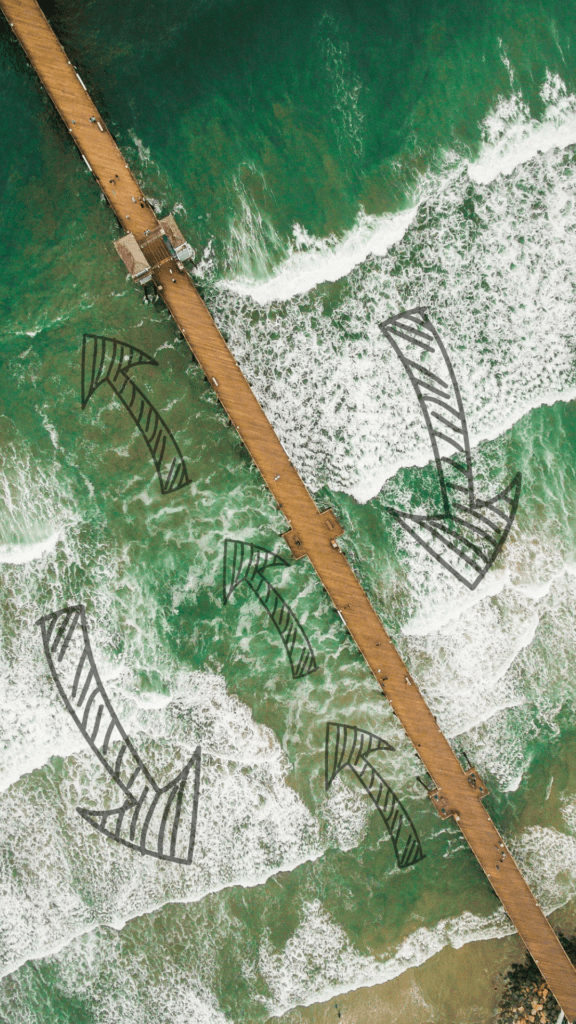Rip Currents (Rips)

Waves break and move toward the beach. The water then moves away from the shallows of the shoreline and out to deeper water. The backwash from these waves travels back out to sea in channels forming rip currents (rips).
The larger the waves coming into the beach, the more water needs to escape. Rips can quickly drag swimmers/surfers off the sandbank and into deep water and cause them to panic when they realize they can’t swim/paddle against the strong rip current.
Identify where the waves are breaking consistently. Look for the whitewater moving toward the beach. Then look to each side where the waves don’t break consistently. Those areas on either side of a sandbank where waves are not breaking are deep water channels for rips.
The coach must:
- Identify already established rip currents.
- Determine conditions at Xizihwan (Uni Beach) that start a rip from suddenly occurring (flash rip).
- Realize that rips change shape and location quickly.
What is a Rip Current?
Rips can be identified by:
- A channel of fast-moving, churning, choppy water on the sea’s surface
- Sandy-colored water, seaweed, and/or debris moving quickly out to sea
- Deeper and darker channels of water between breaking waves and extending beyond the surf zone
Rip Current Survival Plan
• RELAX and float
Stay calm, relax and float with the rip to save energy.
• RAISE one arm to signal for help:
If you feel uncomfortable in the water and need help to get back to shore, stay calm, and raise one arm in the air. Wave your arm from side to side above your head and shout to attract the attention of lifeguards, surfers, or beachgoers who can get help. Try floating on your back to rest and save energy, then repeat signaling for help.
• RIDE the rip
Go with the current flow until it stops, and you can swim back to shore or help arrives.
Ride the rip until the current weakens or stops, or you can confidently stand up on the sandbank.
Rips typically end at the edge of the surf zone. If the rip takes you out to sea, try to swim/paddle parallel to the beach or towards the breaking waves. Use the whitewater surf to help push you to shallow water or the shore.
If you feel confident and the rip has subsided, you can attempt to swim/paddle to the nearest safe point on the shore.
Sweeps
A sweep is similar to a rip current. Sweeps cause water to move across the surf zone due to wind and waves approaching the beach at an angle.
Sweeps tend to move the beginner surfer away from the sandbank into an unsuitable area for the surf lesson.
Understanding Ocean Currents and Tides
Ocean currents and tides are important to understand to stay safe and have fun at the beach. Here’s a simple explanation of what they are:
- Ocean currents work like rivers in the sea, moving water from one place to another. Wind, temperature changes, or the Earth spinning cause them. There are two main types: surface currents and deep-water currents. We usually feel surface currents that affect the ocean’s top layer when we swim. Deep-water currents happen deep down in the ocean, and water density differences cause them.
- Tides make the ocean’s water level go up and down. The moon and sun’s gravity pull on Earth, cause this to happen. There are two main tides: high tide and low tide. High tide is when the water is at its highest, and low tide is at its lowest. Tides change about every six hours, so the beach can look different at different times of the day.
At the beach, being aware of the currents and tides is essential. They can affect how safe swimming or playing in the water is. Always ask a lifeguard for advice if you need help understanding the conditions. Stay safe, and have fun!
COACHING TIP:
A coach or Water Safety Crew (WSC) member must be positioned at the boundary limit of the safe surfing area. The coach or WSC will signal the students to exit the water, return to the shore, walk to the designated entry point, and continue surfing.
